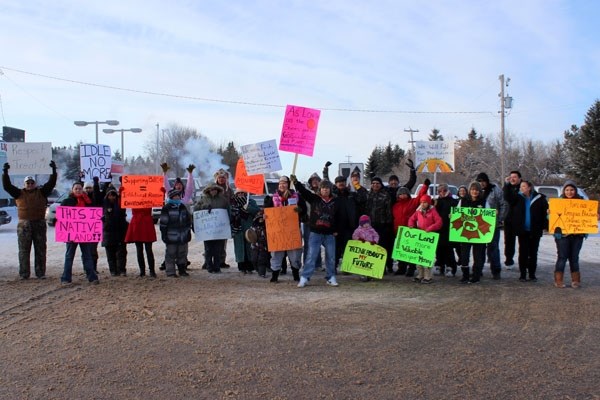Members of Saddle Lake and Whitefish Lake First Nations reserves gathered at the intersection of Highway 29 and Highway 36 at St. Brides on Dec. 24 to hold a peaceful protest, forming a blockade and raising awareness about the Idle No More movement.
The nationwide movement has united First Nations to talk about the issues facing their people and the passing of federal Bill C-45. First Nations have voiced concern with changes made in the bill, such as the removing of federal protection for several lakes and rivers and the management of reserve lands.
“We are united as one nation, one voice, and we say no to Bill C-45 . . . We want the government to honour our treaty and we want to put pressure on Stephen Harper to honour our people,” said Ann Half, an organizer of the blockade. The Dec. 24 blockade saw dozens of protestors block off the intersection between Highway 36 and 29 at St. Brides, toting signs and handing out pamphlets to raise awareness for Idle No More.
Half said the protest was also held in support of Chief Theresa Spence of Attawapiskat First Nation, who has committed herself to a hunger strike until she gets a treaty meeting with Harper.
“We wanted to lift our hearts to her, for her to continue doing what she is doing on behalf of all indigenous peoples . . . and really across the world,” said Half.
Minister of Aboriginal Affairs John Duncan stated in an email to Spence that both he and Kenora MP Greg Rickford attempted to organize meetings with her, but received no response from Spence or her representatives.
Duncan’s email goes on to note that on Dec. 24, Conservative Senator Patrick Brazeau attempted to meet with Spence, but was turned away by her representatives.
Duncan said to Spence in the email, in part, “We are prepared to establish a joint working group which would consist of senior federal and First Nation representatives, and would serve as a forum for clarifying the treaty relationship and exploring ways of addressing First Nations' constitutional rights . . . I remain concerned about your health and hope that you will accept my offer to speak about how we might move forward with improving the treaty relationship.”
Saddle Lake band councillor Leonard Jackson, who was at the blockade, said that Bill C-45 does little to ensure First Nations prosperity and that he will continue to fight under the Idle No More movement until prosperity for indigenous people is ensured.
“Bill C-38 was passed in June, that was the Jobs and Growth and Long-Term Prosperity Act. Bill C-45 is just jobs and growth. Where’s the prosperity for First Nations?” Jackson said.
“Harper rode in onto the political stage on a horse called accountability and transparency. He’s gotten away with a lot. I almost seem to think the characteristics of the old reformist in him have come to resurface.”
Jackson added that at the Crown First Nations gathering in January 2012, Harper stated that the government had no plans to repeal or revise the Indian Act without full consultation with First Nations. Jackson noted that consultation is exactly what Spence’s hunger strike is meant to achieve.
“Bill C-45 is a farce, and as a people with one voice, one mind, one nation, we will do what it takes to make changes happen, because this not only affects us, it affects our white brothers and sisters,” Jackson said. “It’s not difficult for (Harper) to walk down to the valley and say, ‘Here I am’. . . Without consultation, we will continue to have confrontation.”
Half added that the protest is a fight for the future of indigenous children across the country, and also “for our mother, all of our mother, the Earth.
“Today was a peaceful blockade, one small step in a larger direction,” Half said. “As time comes in the new year . . . the movement is going to gain momentum. It’s going to gain strength and we are going to unite in a really big way.”
She added, “As these peaceful protests transpire in the coming days and months ahead we also, as indigenous peoples, open our hearts and we invite our non-indigenous brothers and sisters to join us.”
According to Jan O’Driscoll, a spokesperson with Aboriginal Affairs and Northern Development, the government’s Economic Action Plan 2012 committed over $13 million towards consultations with aboriginal peoples. In an email to the Journal, she said the government “respects its duty to consult with our First Nation partners. In fact, each year, we conduct approximately 5,000 consultations with First Nations covering regulatory issues, environmental assessments, land disposals and treaty issues.
“We will continue to fulfill our duty to consult First Nations and to working in partnership with them to unlock their economic potential."



